Abstract
Previous reports have shown that there is an endogenous opioid component associated with pathophysiological responses to endotoxin. It has been shown that these responses are alleviated by naloxone, a specific opiate antagonist. Results of another study have indicated that leukocytes may mediate some of those responses since leukocyte depletion alleviated the effects of lipopolysaccharide. In view of the above reports as well as the finding that leukocytes produce immunoreactive (ir-) endorphins and corticotropin (ACTH) when stimulated with Newcastle disease virus or ACTH-releasing factor, we postulated that leukocytes may serve as an extrapituitary source of endorphins produced in response to bacterial endotoxin. To test this hypothesis, human peripheral blood leukocytes as well as mouse spleen cells were cultured in vitro with Escherichia coli lipopolysaccharide for 48 h. The lipopolysaccharide (i.e., endotoxin) was shown to induce de novo synthesis of ir-ACTH and ir-endorphins. The leukocyte-derived ir-ACTH had a molecular weight of approximately 2,900 and demonstrated a bioactivity similar to that of pituitary-derived ACTH. The lymphocyte-derived ir-endorphin comigrated with alpha- and gamma-endorphin at approximately 1,800 daltons and was shown to bind to brain opiate receptors. These findings imply that leukocyte-derived endorphins may be involved in the pathophysiological response to endotoxin.
Full text
PDF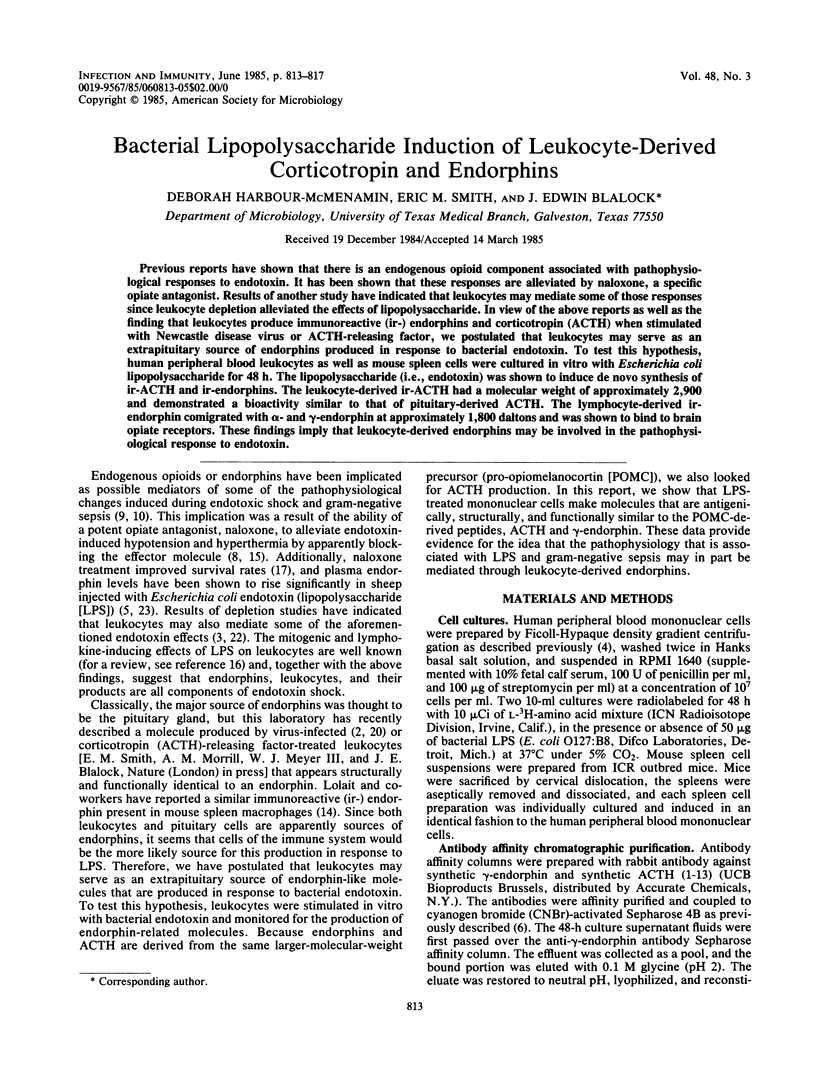
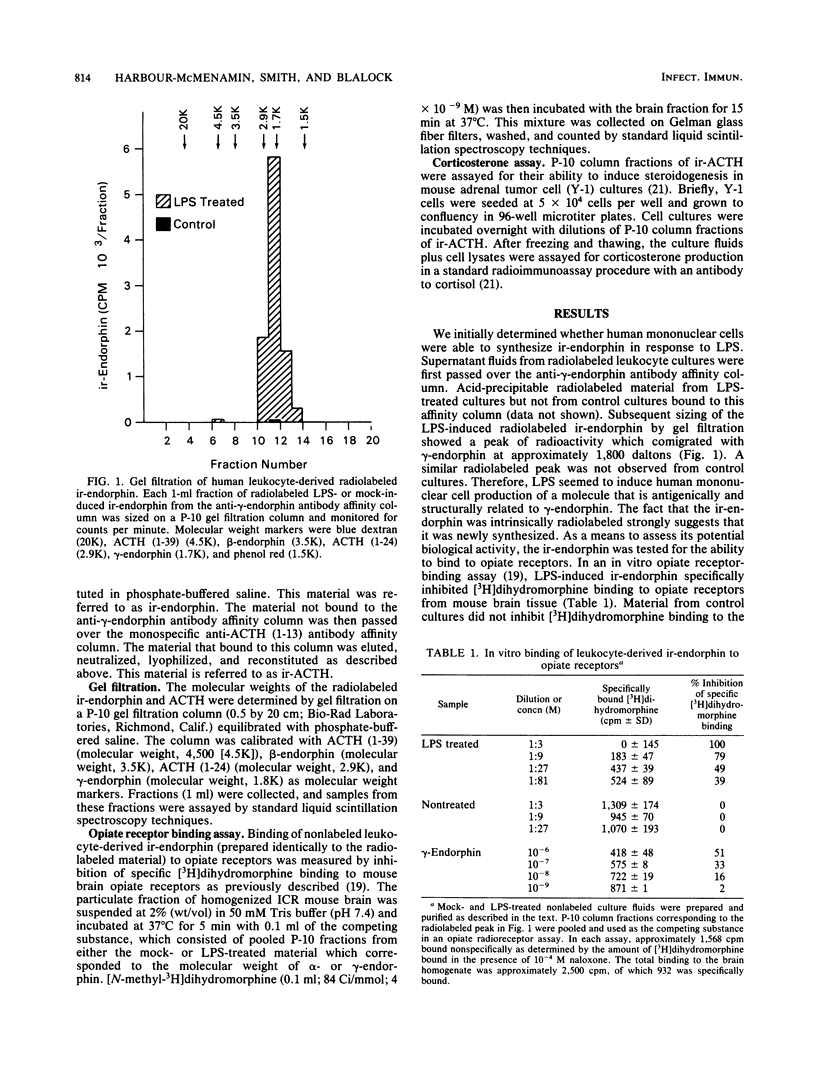
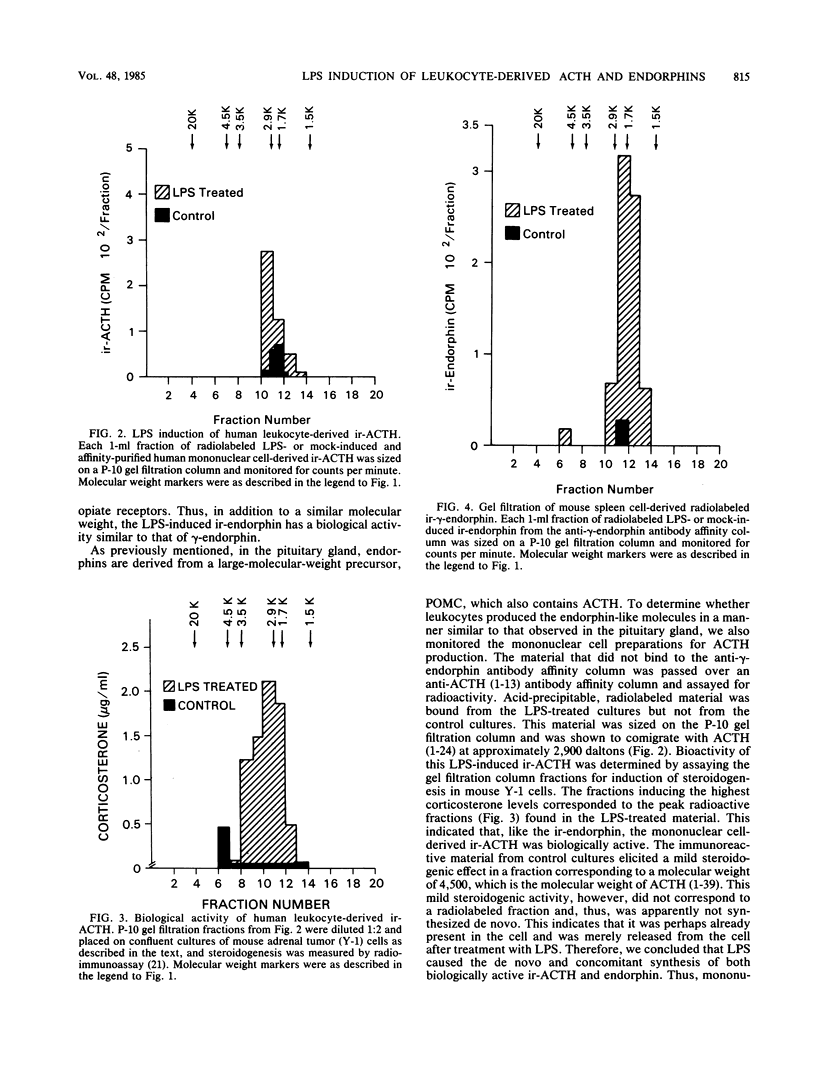
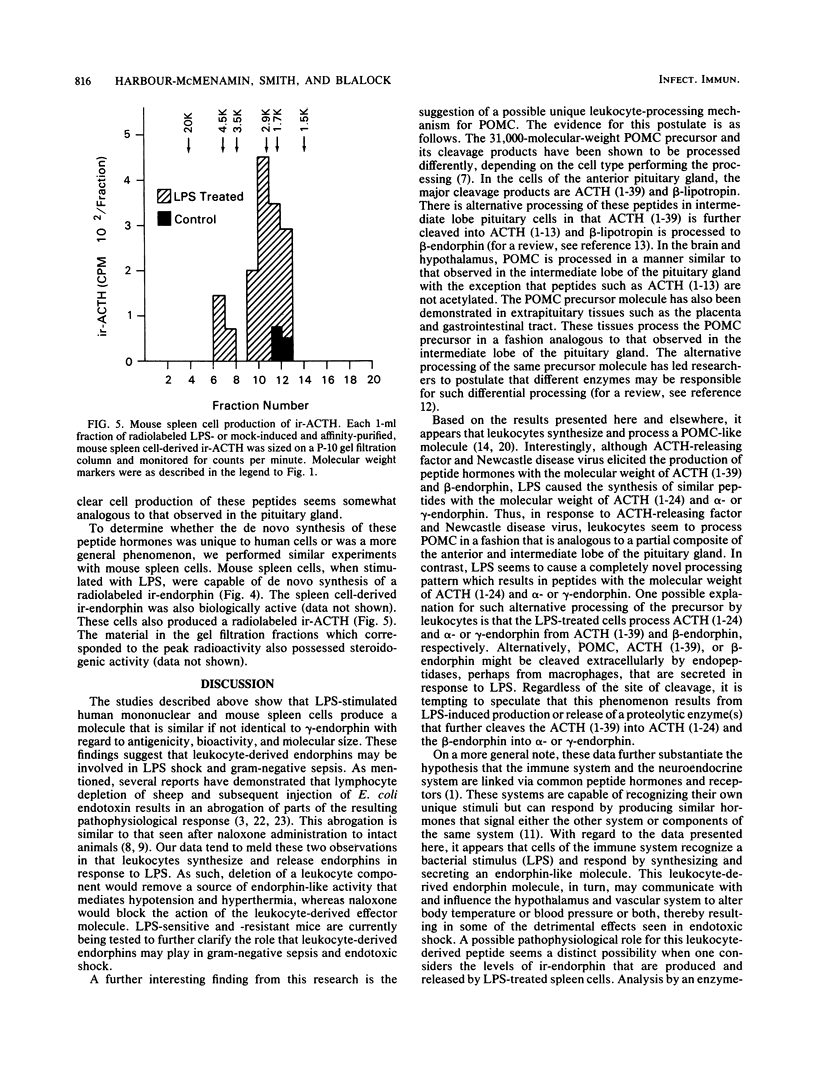
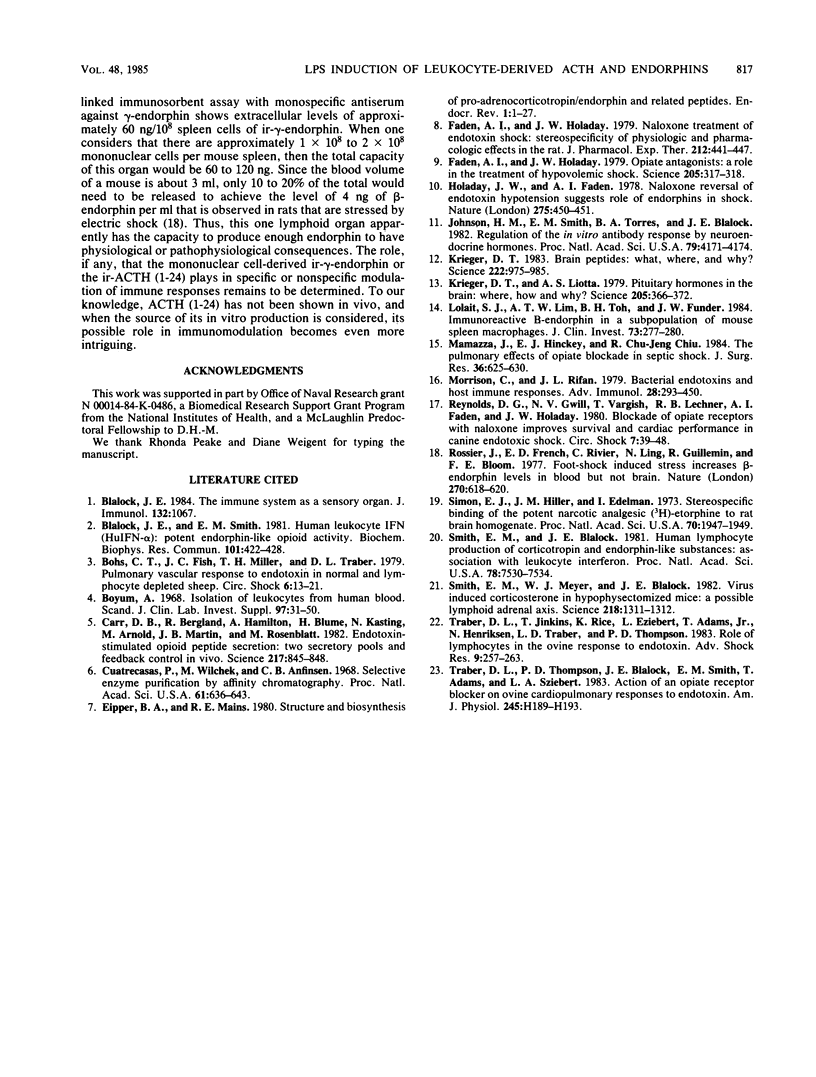
Selected References
These references are in PubMed. This may not be the complete list of references from this article.
- Blalock J. E. The immune system as a sensory organ. J Immunol. 1984 Mar;132(3):1067–1070. [PubMed] [Google Scholar]
- Bohs C. T., Fish J. C., Miller T. H., Traber D. L. Pulmonary vascular response to endotoxin in normal and lymphocyte depleted sheep. Circ Shock. 1979;6(1):13–21. [PubMed] [Google Scholar]
- Böyum A. Isolation of leucocytes from human blood. Further observations. Methylcellulose, dextran, and ficoll as erythrocyteaggregating agents. Scand J Clin Lab Invest Suppl. 1968;97:31–50. [PubMed] [Google Scholar]
- Carr D. B., Bergland R., Hamilton A., Blume H., Kasting N., Arnold M., Martin J. B., Rosenblatt M. Endotoxin-stimulated opioid peptide secretion: two secretory pools and feedback control in vivo. Science. 1982 Aug 27;217(4562):845–848. doi: 10.1126/science.6285473. [DOI] [PubMed] [Google Scholar]
- Cuatrecasas P., Wilchek M., Anfinsen C. B. Selective enzyme purification by affinity chromatography. Proc Natl Acad Sci U S A. 1968 Oct;61(2):636–643. doi: 10.1073/pnas.61.2.636. [DOI] [PMC free article] [PubMed] [Google Scholar]
- Eipper B. A., Mains R. E. Structure and biosynthesis of pro-adrenocorticotropin/endorphin and related peptides. Endocr Rev. 1980 Winter;1(1):1–27. doi: 10.1210/edrv-1-1-1. [DOI] [PubMed] [Google Scholar]
- Faden A. I., Holaday J. W. Naloxone treatment of endotoxin shock: stereospecificity of physiologic and pharmacologic effects in the rat. J Pharmacol Exp Ther. 1980 Mar;212(3):441–447. [PubMed] [Google Scholar]
- Faden A. I., Holaday J. W. Opiate antagonists: a role in the treatment of hypovolemic shock. Science. 1979 Jul 20;205(4403):317–318. doi: 10.1126/science.451606. [DOI] [PubMed] [Google Scholar]
- Holaday J. W., Faden A. I. Naloxone reversal of endotoxin hypotension suggests role of endorphins in shock. Nature. 1978 Oct 5;275(5679):450–451. doi: 10.1038/275450a0. [DOI] [PubMed] [Google Scholar]
- Johnson H. M., Smith E. M., Torres B. A., Blalock J. E. Regulation of the in vitro antibody response by neuroendocrine hormones. Proc Natl Acad Sci U S A. 1982 Jul;79(13):4171–4174. doi: 10.1073/pnas.79.13.4171. [DOI] [PMC free article] [PubMed] [Google Scholar]
- Krieger D. T. Brain peptides: what, where, and why? Science. 1983 Dec 2;222(4627):975–985. doi: 10.1126/science.6139875. [DOI] [PubMed] [Google Scholar]
- Krieger D. T., Liotta A. S. Pituitary hormones in brain: where, how, and why? Science. 1979 Jul 27;205(4404):366–372. doi: 10.1126/science.221983. [DOI] [PubMed] [Google Scholar]
- Lolait S. J., Lim A. T., Toh B. H., Funder J. W. Immunoreactive beta-endorphin in a subpopulation of mouse spleen macrophages. J Clin Invest. 1984 Jan;73(1):277–280. doi: 10.1172/JCI111203. [DOI] [PMC free article] [PubMed] [Google Scholar]
- Mamazza J., Hinchey E. J., Chiu R. C. The pulmonary effects of opiate blockade in septic shock. J Surg Res. 1984 Jun;36(6):625–630. doi: 10.1016/0022-4804(84)90150-1. [DOI] [PubMed] [Google Scholar]
- Morrison D. C., Ryan J. L. Bacterial endotoxins and host immune responses. Adv Immunol. 1979;28:293–450. doi: 10.1016/s0065-2776(08)60802-0. [DOI] [PubMed] [Google Scholar]
- Reynolds D. G., Gurll N. J., Vargish T., Lechner R. B., Faden A. I., Holaday J. W. Blockade of opiate receptors with naloxone improves survival and cardiac performance in canine endotoxic shock. Circ Shock. 1980;7(1):39–48. [PubMed] [Google Scholar]
- Rossier J., French E. D., Rivier C., Ling N., Guillemin R., Bloom F. E. Foot-shock induced stress increases beta-endorphin levels in blood but not brain. Nature. 1977 Dec 15;270(5638):618–620. doi: 10.1038/270618a0. [DOI] [PubMed] [Google Scholar]
- Simon E. J., Hiller J. M., Edelman I. Stereospecific binding of the potent narcotic analgesic (3H) Etorphine to rat-brain homogenate. Proc Natl Acad Sci U S A. 1973 Jul;70(7):1947–1949. doi: 10.1073/pnas.70.7.1947. [DOI] [PMC free article] [PubMed] [Google Scholar]
- Smith E. M., Blalock J. E. Human lymphocyte production of corticotropin and endorphin-like substances: association with leukocyte interferon. Proc Natl Acad Sci U S A. 1981 Dec;78(12):7530–7534. doi: 10.1073/pnas.78.12.7530. [DOI] [PMC free article] [PubMed] [Google Scholar]
- Smith E. M., Meyer W. J., Blalock J. E. Virus-induced corticosterone in hypophysectomized mice: a possible lymphoid adrenal axis. Science. 1982 Dec 24;218(4579):1311–1312. doi: 10.1126/science.6183748. [DOI] [PubMed] [Google Scholar]
- Traber D. L., Jinkins J., Rice K., Sziebert L., Adams T., Jr, Henriksen N., Traber L. D., Thomson P. D. Role of lymphocytes in the ovine response to endotoxin. Adv Shock Res. 1983;9:257–263. [PubMed] [Google Scholar]
- Traber D. L., Thomson P. D., Blalock J. E., Smith E. M., Adams T., Jr, Sziebert L. A., Traber L. D. Action of an opiate receptor blocker on ovine cardiopulmonary responses to endotoxin. Am J Physiol. 1983 Aug;245(2):H189–H193. doi: 10.1152/ajpheart.1983.245.2.H189. [DOI] [PubMed] [Google Scholar]


